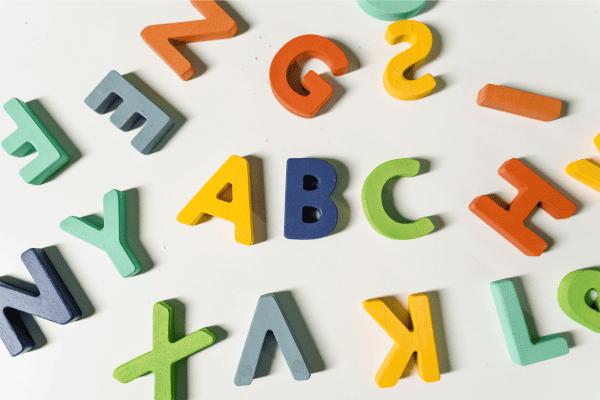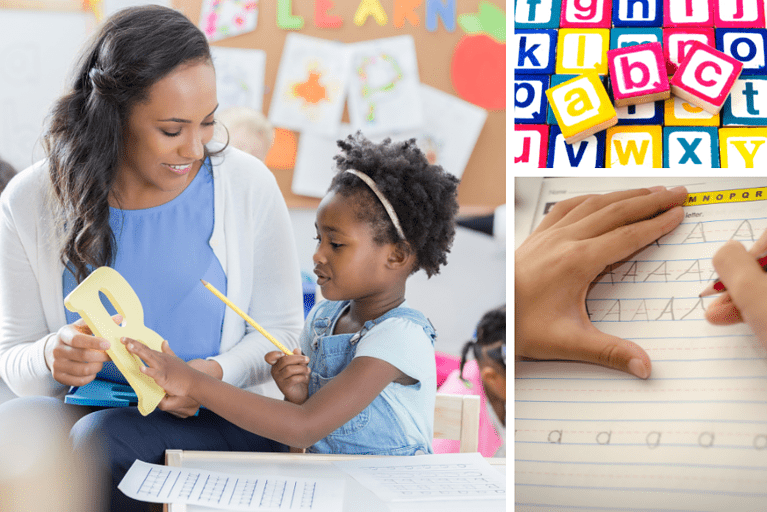Should you teach uppercase or lowercase letters first? Let’s discuss the different ways to teach uppercase and lowercase letters. Then, I will share what different reading experts suggest.

To develop your child’s literacy skills, teaching letters is going to be a crucial step! However, it can be confusing to determine which letters to teach first. Should you begin with uppercase or lowercase letters? Should you teach them both at the same time?
Let’s discuss the different approaches. Each approach has its own advantages and disadvantages. Then, I will share what different reading experts recommend.
Teaching Uppercase Letters First – Why Uppercase Matters

There are a few reasons why uppercase letters may be taught first. Let’s consider a few of those reasons:
- Uppercase letters can be more distinct. This would essentially make it easier for children to recognize.
- Some argue that because many uppercase letters have straight lines, they are easier for children to write. Additionally, they all are the same height. Pretty neat, huh?
- Learning uppercase letters allows children to quickly become familiar with the alphabet, which can help build their confidence and motivation.
It’s common for children who are entering kindergarten to know more uppercase letters compared to lowercase letters. That could simply be because of their early childhood instruction. It does not necessarily mean that uppercase letters are easier for children to recognize.
Teaching Lowercase Letters First – Why Lowercase Matters
 Teaching lowercase letters are important to all early readers! After all, when we read, we are typically reading lowercase letters. Let’s review some reasons why teaching lowercase letters first may be beneficial.
Teaching lowercase letters are important to all early readers! After all, when we read, we are typically reading lowercase letters. Let’s review some reasons why teaching lowercase letters first may be beneficial.
- Lowercase letters are used more frequently in print. Did you know lowercase letters make up roughly 95% of the letters in print? No wonder many educators and reading experts believe lowercase should take precedence over uppercase letters.
- Some experts argue that lowercase letters are actually easier for young children to recognize. They’re less complex in shape and have fewer variations. Therefore, children have an easier time recognizing and writing lowercase letters.
- Lowercase letters are more versatile! They are used in many different contexts- from handwriting to digital texts to environmental print.
Teaching Uppercase and Lowercase Letters At the Same Time
With this approach, both uppercase and lowercase letters would be taught simultaneously. Both letters are important for reading and writing so let’s discuss why this integrative approach may be the best approach for your child.

- Both lowercase and uppercase letters are seen in print. While lowercase letters are more common, uppercase letters can be more common in other types of print, such as environmental print. Just think of stop signs!
- Instruction in both uppercase and lowercase letters is important for visual memory. Exposure to different types of print will help enhance your child’s visual memory.
If you decide to teach both uppercase and lowercase letters at the same time, it will be more time-consuming. After all, you’re teaching double the content. Additionally, you will need double the materials! Again, this is because you are teaching more material! You will need more resources and materials simply because your child is learning more content.
So, Uppercase or Lowercase First? It Depends (According to Popular Curriculums)
The debate on whether to introduce uppercase letters or lowercase letters first is ongoing. We know that both types of letters are important for reading and writing. So, what should we do? Let’s let the industry leaders weigh in so you can make your own informed decision going forward.
Handwriting Without Tears – Uppercase Letters First
Handwriting Without Tears is a popular handwriting and writing curriculum that is recommended by many educators. Under the HWOT (Handwriting Without Tears) method, children are taught uppercase letters first. The HWOT team argues that capital letters are more developmentally appropriate for younger learners. They are all the same height and use similar writing formation strokes. Learning uppercase letters also makes for an easier transition to lowercase letters.
For more information on this curriculum, you can visit their website by clicking here.
Fundations – Lowercase Letters First
Fundations is a phonics program for grades kindergarten to 3rd by Wilson Reading System. This program recommends teaching lowercase letters first. This is because lowercase letters are found more frequently in print compared to uppercase letters. Additionally, Fundations argues that because lowercase letters are rounder, they are easier to write and build into words and sentences. Therefore, writing is a lot easier!
For more information on this curriculum, you can visit their website by clicking here.
Here’s What I Recommend…
Because uppercase letters and lowercase letters are important in all aspects of reading and writing, I believe it is necessary to teach your child both forms of the letter.

That means when I am teaching an individual letter, I will teach the uppercase from AND the lowercase form. Here’s why…
You want the best of both worlds, right? Uppercase letters are important. And so are lowercase letters. In order for your child to become a skilled reader, they will need knowledge of letters in both forms.
However, I do not spend an equal amount of instructional time on both forms of the letter. I will spend much more time on lowercase letters compared to uppercase letters. This is simply because lowercase letters are the most common types of letters in print!
One Final Note…
This post was all about which form of the letter to teach first – uppercase letters or lowercase letters. Different curriculums will use different methods, as shown above. Personally, I teach both forms of the letter simultaneously.
As always, it is important to remember that every child is unique. Everyone learns differently. Therefore, it is essential to be flexible and adjust your teaching methods to best meet the needs of your child. Don’t forget that you are the expert on your child.







